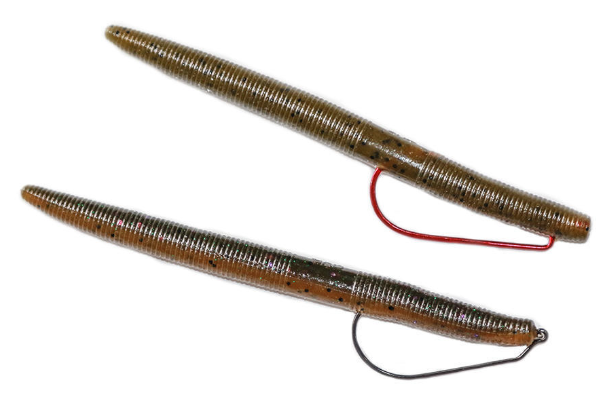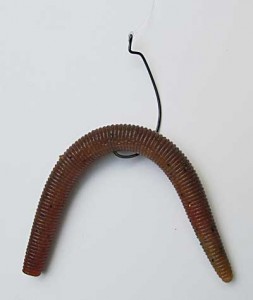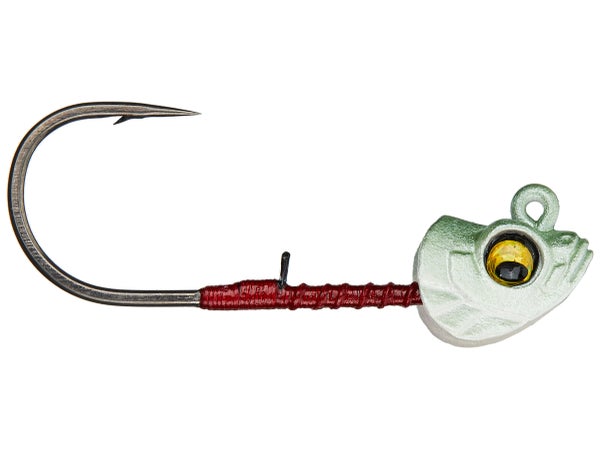If you’ve ever walked down the fishing aisle at a sporting store, you’ve realized there are literally hundreds (if not thousands) of different types of artificial baits out there. And if you are relatively new into fishing, you may find yourself scratching your head and wondering “How do I put a hook in that?” or “How would I fish that?”. If this sounds familiar, keep reading–this article was written for you.
Worm Category / Stickbaits

Probably one of the most common terms you will hear when it comes to worm imitations is “senko”. While many anglers use this term universally to refer to any worm-type lure, it belongs to Gary Yamamoto himself.

The most common size we use is the Gary Yamamoto 5” Senko. In my opinion–stick with green. Fish around Lake Wallenpaupack seem to love shades of green. For this rig, you will want to pick up some 2/0 or 3/0 offset shank hooks.
This hook size and style will allow you to rig what is referred to as “Texas Rig”. This technique is where you insert the point of the hook about 1/4” into the head of the plastic, work it out, and feed the worm body up the shank of the hook into the offset near the eye-hole. Then all you need to do is feed the hook point through the body of the worm and just BARELY let the hook point expose itself.

The benefit of this approach is mainly that you essentially become “weed free”. With the hook point covered by a thin layer of plastic, you can work this presentation through the thickest of lily-pads, grass, weed beds, etc. without the risk of snagging. When a fish can’t resist and grabs hold, the hook set itself will expose the hook point and (hopefully) land you a nice catch!

An alternative presentation in the worm imitation category is called the “Wacky Rig”. This is simple. Get yourself a circle hook and a worm, find the center, and feed the hook through the worm. Fish typically can’t resist this presentation, but be aware that you may lose more tackle this way and will likely get more frustrated if you are trying to fish this in any sort of thick cover.
Swimbaits, Jerkbaits & Flukes
Lures in this category should be rigged in such a way where the retrieve action is what causes a strike. These baits imitate shad, minnows, baitfish, etc. and typically have some sort of tail that moves during the retrieve. Our brand of preference, of course, is Keitech USA.
You have two popular options when it comes to this category. You’ll want to pick up some belly-weighted hooks as well as some 1/8 oz, 1/4 oz, or even 1/2 oz jig heads. Let’s look first as the belly-weighted hook rigs.

I personally prefer the belly-weighted hooks which have a screw top. This allows for easy rigging. All you need to do is screw the head of the swimbait onto the hook until the swimbait is all the way up to the eyehole. Then, figure out where the hook point naturally wants to poke through the body of the swimbait and feed it through–carefully. You should end up with something like this.
Just like the Texas Rig options above, the hook point should be just BARELY exposed. Many swimbaits even have a slit down the back of the lure that the hook point sits in nicely. This is by design–when a bass hits it, you set the hook, and the swimbait will compress and warrant a perfect hook-up for you.

The other option pictured above is rigging swimbaits with a jig head. Jig heads are weighted hooks that often imitate the head of a baitfish. Many have imitation eyes or colors–but don’t concern yourself so much with the type of jig head and instead worry about making sure the lure is rigged properly. An improperly rigged swimbait can lead to poor performance and movement in the water which ultimately will warrant a lower strike and hook-up ratio for you.
To rig the jig head presentation, you just feed the hook point and shank directly through the head of the swimbait, all the way down to mid-back, and then poke the hook point out through the swimbait back. Too far and you will end up with a squeezed look; too shallow and you will stretch the swimbait out. Make sure you get it just right…. trust me, it matters!!
There are many other plastics–crawfish imitations, eel imitations, lizard imitations–the list goes on and on. Even hollow bodied top-water frogs can be considered soft plastics. Many of these can be rigged using the Texas Rig style. Depending on size, length, thickness, etc. you may need to change up your hook size and shape.
The most important take-away when it comes to rigging is to make sure you set yourself up so that the presentation of the soft plastic in the water is optimal. The movement underwater is what drives the fish to strike. Rigging your lures improperly will only prevent you from bringing in the big’gen you’ve been chasing in your dreams. No amount of expensive rods, reels, or fishing line is going to correct an improperly rigged lure.
Until next time, tight lines fishing freaks! Happy 4th of July.


